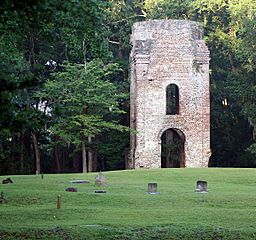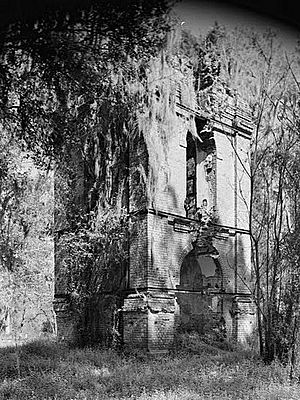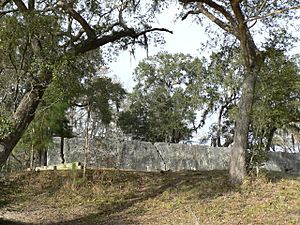Colonial Dorchester State Historic Site facts for kids
Quick facts for kids Colonial Dorchester State Historic Site |
|
|---|---|

Cemetery and ruins of the St. George Bell Tower
|
|
| Nearest city | Summerville, SC |
| Area | 325 acres (1 km2) |
| Open | 1960 |
Colonial Dorchester State Historic Site is a cool place to visit in South Carolina. It's located right by the Ashley River, close to Summerville. This park lets you explore what life was like way back in South Carolina's early days.
The site became a state park in 1969. It was also added to the National Register of Historic Places that same year. The park covers 325 acres. Here, you can see an old fort made of oyster shells, a tall church bell tower, and even old shipping docks. There are also burial sites and ongoing digs where archaeologists are still finding out new things about the past!
Contents
Exploring Dorchester's Past
This historic site is where the old town of Dorchester used to be. It sits on a piece of land between the Ashley River and Dorchester Creek. This creek was once called Boshoe Creek.
How Dorchester Started
In 1675, John and Mary Smith came to Carolina from England. John Smith received a large piece of land in 1676. This land included the future site of Dorchester.
After John Smith passed away, a group of settlers came from Dorchester, Massachusetts. In 1696, they bought over 4,000 acres of land. Reverend Joseph Lord led these settlers. They were Congregationalists and wanted to "settle the gospel."
On January 26, 1696, Reverend Lord gave his first sermon. This was at the spot chosen for their new church. This church later became known as St. George's Anglican Church. After the church was built, the town of Dorchester grew quickly. More settlers arrived from Massachusetts.
A Busy Trading Town
Dorchester's location was perfect for trade. Roads led to Charleston and deeper into the colony. The Ashley River was like a highway for shipping goods. Trade with Native Americans helped the town grow. Farmers also started growing rice and indigo as cash crops.
By the mid-1700s, Dorchester was doing very well. Wealthy planters and merchants benefited from this busy trading town. Even though it stayed fairly small, it was a major center for trade. A fair started in 1723. A free school opened in 1734. By 1781, Dorchester had about 40 houses.
The Church and Bell Tower
St. George's Anglican Church was built in the center of Dorchester. It was finished in 1719. The tall Bell Tower, which you can still see today, was added in 1751.
During the American Revolution, Dorchester became a military camp. The church was used by American forces. Later, British troops took over Dorchester. They used the large church and then burned it before leaving in December 1781.
The church was repaired after the war. But like the town, it was soon left empty. People even took bricks from the church to use for other buildings. An old article from 1858 said people were "afraid to touch the tower." They thought it might fall on them. So, the tower remained standing.
The 1886 Charleston earthquake damaged the tower. It split along its height. For many years, iron straps held it together. It was finally repaired in the early 1960s.
The Fort and Powder Magazine
Dorchester was also important for military reasons. People worried about a possible French invasion. So, a powder magazine and a fort were built between 1757 and 1760.
The fort was made of "tabby." Tabby is a type of concrete. It's made from lime, sand, and oyster shells. The fort's walls formed a rectangle around the magazine. It had strong points called half-bastions at each corner. Soldiers could fire from these points to protect the walls.
The French invasion never happened. The town was quiet until the American Revolution began in 1775. Dorchester became a military supply center. American troops gathered there. In 1775, the magazine was made stronger. Captain Francis Marion commanded the fort.
After Charleston fell to the British in 1780, Dorchester became a British outpost. But in December 1781, American forces attacked. They were led by Colonel Wade Hampton and General Nathanael Greene. The British were forced out of Dorchester.
After the war, the fort was used for making roof tiles. The magazine became a kiln to bake the clay tiles. But soon, the fort was also abandoned. Its history was forgotten. People even thought it was built by the Spanish or for protection from Native Americans. Locals started calling it "Fort Dorchester."
Why the Town Declined
The town never really recovered after the war. Historians have different ideas why Dorchester declined. Some say it was because of the damage from British soldiers. Others think it was due to malaria in the swampy area.
In 1788, a traveler wrote about Dorchester. They said it looked like it was once a "considerable town." They saw the "ruins of an elegant church" and signs of "well-built houses."
As Dorchester was left empty, a new town grew nearby. This new town was Summerville. It was built on higher, drier land. People even took bricks from the old Dorchester buildings to use in Summerville.
Fun Things to Do at the Park
- Geocaching: Go on a treasure hunt using GPS coordinates!
- Interpretive Trails: Walk along paths with signs that tell you about the park's history.
- Archaeological Programs: Join in on digs and learn how archaeologists uncover the past. These programs happen all year.
- Picnic Areas: Enjoy a meal outdoors at the picnic tables. Please note that grills are not allowed.
- Fishing: You can fish in the freshwater, but you need a fishing license.
- Wildlife Watching: Look for animals like American alligators, white-tailed deer, foxes, and raccoons. You might even spot bald eagles and various hawks!
Hours and Admission
- Admission:
- $3 for Adults
- $1.25 for SC Seniors
- Free for children aged 15 and younger.
- Hours of Operation:
- Daily 9:00 am – 6:00 pm during Daylight Saving Time
- Daily 9:00 am – 5:00 pm the rest of the year.
- Dates Closed: Christmas Day
- Office Hours: Daily 11:00 am – 12:00 pm



